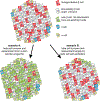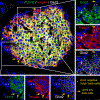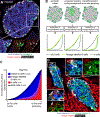Evidence for a Neogenic Niche at the Periphery of Pancreatic Islets
- PMID: 30264410
- PMCID: PMC6570402
- DOI: 10.1002/bies.201800119
Evidence for a Neogenic Niche at the Periphery of Pancreatic Islets
Abstract
We recently discovered a novel subset of beta cells that resemble immature beta cells during pancreas development. We named these "virgin" beta cells as they do not stem from existing mature beta cells. Virgin beta cells are found exclusively at the islet periphery in areas that we therefore designated as the "neogenic niche." As beta cells are our only source of insulin, their loss leads to diabetes. Islets also contain glucagon-producing alpha cells and somatostatin-producing delta cells, that are important for glucose homeostasis and form a mantle surrounding the beta cell core. This 3D architecture is important and determines access to blood flow and innervation. We propose that the distinctive islet architecture may also play an important, but hitherto unappreciated role in generation of new endocrine cells, including beta cells. We discuss several predictions to further test the contribution of the neogenic niche to beta cell regeneration.
Keywords: Urocortin 3; alpha cells; lineage tracing; pancreas islets; stem cells; transdifferentiation; virgin beta cells.
© 2018 WILEY Periodicals, Inc.
Figures






Comment in
-
A Niche Mechanism for β-Cell Regeneration in Type 1 Diabetes.Bioessays. 2018 Nov;40(11):e1800177. doi: 10.1002/bies.201800177. Epub 2018 Oct 9. Bioessays. 2018. PMID: 30298934 No abstract available.
Similar articles
-
Virgin Beta Cells Persist throughout Life at a Neogenic Niche within Pancreatic Islets.Cell Metab. 2017 Apr 4;25(4):911-926.e6. doi: 10.1016/j.cmet.2017.03.017. Cell Metab. 2017. PMID: 28380380 Free PMC article.
-
Diabetes recovery by age-dependent conversion of pancreatic δ-cells into insulin producers.Nature. 2014 Oct 23;514(7523):503-7. doi: 10.1038/nature13633. Epub 2014 Aug 20. Nature. 2014. PMID: 25141178 Free PMC article.
-
Regeneration of pancreatic non-β endocrine cells in adult mice following a single diabetes-inducing dose of streptozotocin.PLoS One. 2012;7(5):e36675. doi: 10.1371/journal.pone.0036675. Epub 2012 May 7. PLoS One. 2012. PMID: 22586489 Free PMC article.
-
Signals in the pancreatic islet microenvironment influence β-cell proliferation.Diabetes Obes Metab. 2017 Sep;19 Suppl 1(Suppl 1):124-136. doi: 10.1111/dom.13031. Diabetes Obes Metab. 2017. PMID: 28880471 Free PMC article. Review.
-
[Actual problems of biology of pancreatic acino-insular cells].Vestn Ross Akad Med Nauk. 2010;(7):28-35. Vestn Ross Akad Med Nauk. 2010. PMID: 20795400 Review. Russian.
Cited by
-
Enteroviral infections are not associated with type 2 diabetes.Front Endocrinol (Lausanne). 2023 Oct 30;14:1236574. doi: 10.3389/fendo.2023.1236574. eCollection 2023. Front Endocrinol (Lausanne). 2023. PMID: 38027145 Free PMC article.
-
Regeneration of Pancreatic Beta Cells by Modulation of Molecular Targets Using Plant-Derived Compounds: Pharmacological Mechanisms and Clinical Potential.Curr Issues Mol Biol. 2023 Jul 26;45(8):6216-6245. doi: 10.3390/cimb45080392. Curr Issues Mol Biol. 2023. PMID: 37623211 Free PMC article. Review.
-
Ontology of the apelinergic system in mouse pancreas during pregnancy and relationship with β-cell mass.Sci Rep. 2021 Jul 29;11(1):15475. doi: 10.1038/s41598-021-94725-0. Sci Rep. 2021. PMID: 34326390 Free PMC article.
-
Sleeve Gastrectomy and Roux-En-Y Gastric Bypass. Two Sculptors of the Pancreatic Islet.J Clin Med. 2021 Sep 17;10(18):4217. doi: 10.3390/jcm10184217. J Clin Med. 2021. PMID: 34575329 Free PMC article. Review.
-
The biological functions and pathological mechanisms of CASK in various diseases.Heliyon. 2024 Mar 29;10(8):e28863. doi: 10.1016/j.heliyon.2024.e28863. eCollection 2024 Apr 30. Heliyon. 2024. PMID: 38638974 Free PMC article. Review.
References
Publication types
MeSH terms
Grants and funding
LinkOut - more resources
Full Text Sources
Other Literature Sources
Research Materials

